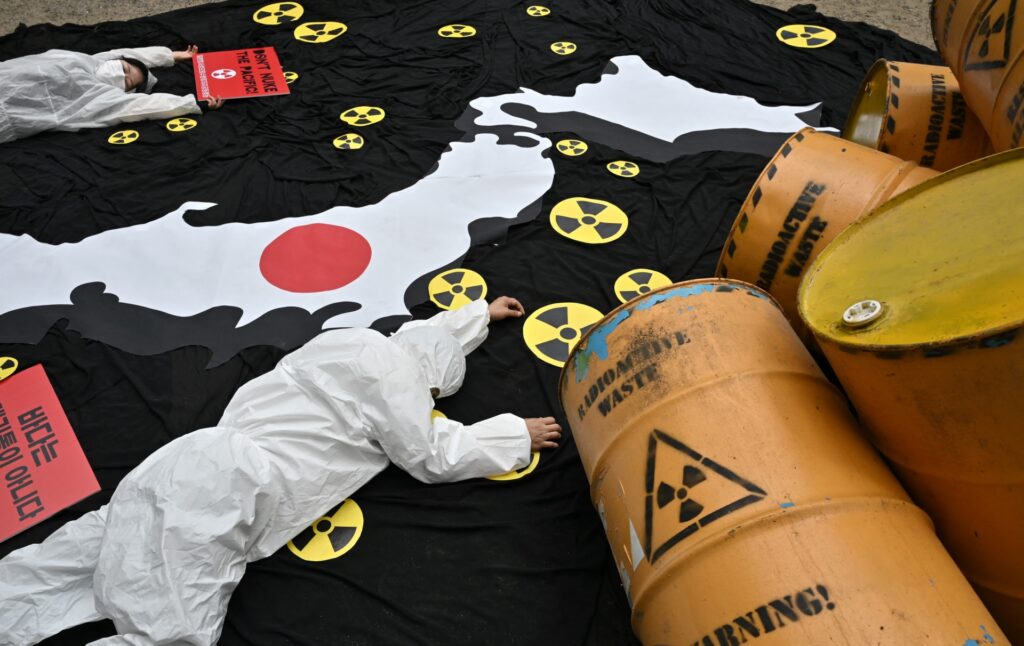South Koreans are reportedly hoarding sea salt and other ocean products in nervous anticipation of Japan dumping over a million metric tons of treated radioactive water from the Fukushima nuclear plant into the ocean.
The precise date of the wastewater release has not been scheduled yet, and while Japanese engineers are confident the filtered water will pose no health risks as it disperses through the vast Pacific Ocean, many South Koreans have decided to stock up on goods harvested from the sea, especially salt.
“I recently bought 5 kilograms of salt. As a mother raising two children, I can’t just sit back and do nothing. I want to feed them safely,” a woman living near Seoul told Reuters on Thursday.
“I came to buy salt but there’s none left. There was none the last time I came too,” 73-year-old shopper Kim Myung-ok said.
“The release of water is worrying. We’re old and have lived enough, but I worry about the children,” said Kim.

South Korean environmental activists perform during a protest in Seoul against Japan’s plan to discharge Fukushima’s radioactive water into the sea on June 8, 2022. (Photo by JUNG YEON-JE/AFP via Getty Images)
The demand for sea salt surged to such heights over the past two months that prices rose by 27 percent. The South Korean government announced on Wednesday that it will begin releasing 50 tons of salt per day from its reserves at a 20 percent discount through July 11 to ensure adequate supply and bring prices down.
India’s WION News called it outright “panic-buying” and saw deep apprehension among South Korean fishermen, who fear their livelihoods could be ruined if consumers stop buying Pacific fish. South Korea has already banned imported fish caught anywhere near Fukushima, and Hong Kong is considering a similar measure.
The South Korean government said last week that it saw high demand and rising prices but no sign of salt hoarding. However, Nikkei Asia talked to one shop that said sales of sea salt have “ceased due to a supply shortage.”
Government officials noted some of the price increase was due to excessive precipitation over the past few months, which made it difficult to produce sun-dried sea salt and also pointed to rising labor costs as a factor.
The Fukushima plant was damaged by an earthquake and tsunami in 2011, causing three of its reactors to melt down. Large amounts of water were pumped into the reactor cores to cool them down. The radioactive water was then moved into a thousand huge storage tanks, which are now at 97 percent capacity 12 years later. The tanks are projected to hit full capacity sometime in 2024 if the water is not discharged into the ocean.
The company that operates the Fukushima plant, Tokyo Electric Power Company (TEPCO), devised a plan to treat and slowly release over 1.3 million metric tons of wastewater over the next 20 to 30 years. The water has been cleaned to the point where it contains only trace amounts of tritium, which is effectively impossible to remove with current technology.
A number of nuclear scientists from around the world have approved of Japan’s discharge plan, noting that the amount of water to be released over a long period of time is comparatively small, and water with higher levels of tritium has been discharged in other situations without causing human or environmental harm. Some nuclear experts argue that keeping the Fukushima water stored in tanks that might rupture under another earthquake or tsunami is much more dangerous than dispersing the water into the Pacific Ocean.
The International Atomic Energy Agency (IAEA) published a report last month that found TEPCO has handled the Fukushima water with proper care. The IAEA is running tests on the water before its prospective release and has said no significant levels of radionuclides have been found, besides the expected tritium.
Japan’s neighbors and its own fishing industry remain largely unconvinced. Fishing in the Fukushima area did not emerge from American and European safety restrictions until 2021.
“We cannot support the government’s stance that an ocean release is the only solution. Whether to release the water into the sea or not is a government decision, and in that case we want the government to fully take responsibility,” said Masanobu Sakamoto, president of Japan’s National Federation of Fisheries Cooperatives.

Protesters wearing masks of Japanese Prime Minister Fumio Kishida (L) and South Korean President Yoon Suk Yeol perform during a rally against the Japanese government’s decision to release treated radioactive water from the Fukushima nuclear power plant in Seoul, South Korea, May 20, 2023. (AP Photo/Ahn Young-joon)
South Korean opposition leaders are trying to work up a cooperative effort with other Pacific nations to block the Fukushima water release. Chinese social media users are threatening to boycott Japanese products if the release goes ahead as planned. Residents of Taiwan have protested against the plan, although the Taiwanese government says it has plans to protect its territorial waters from contamination, and it estimates less than half a percent of the Fukushima water would reach Taiwan in any event.
Japanese regulators began their final inspections of the wastewater discharge system at Fukushima on Wednesday, the day after TEPCO announced the final piece of equipment needed for pumping the water has been installed. The final inspection is scheduled to last for three days, and permits for releasing the water could be issued as soon as a week later.

COMMENTS
Please let us know if you're having issues with commenting.